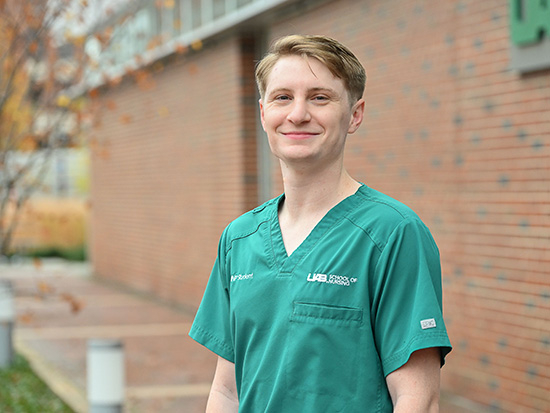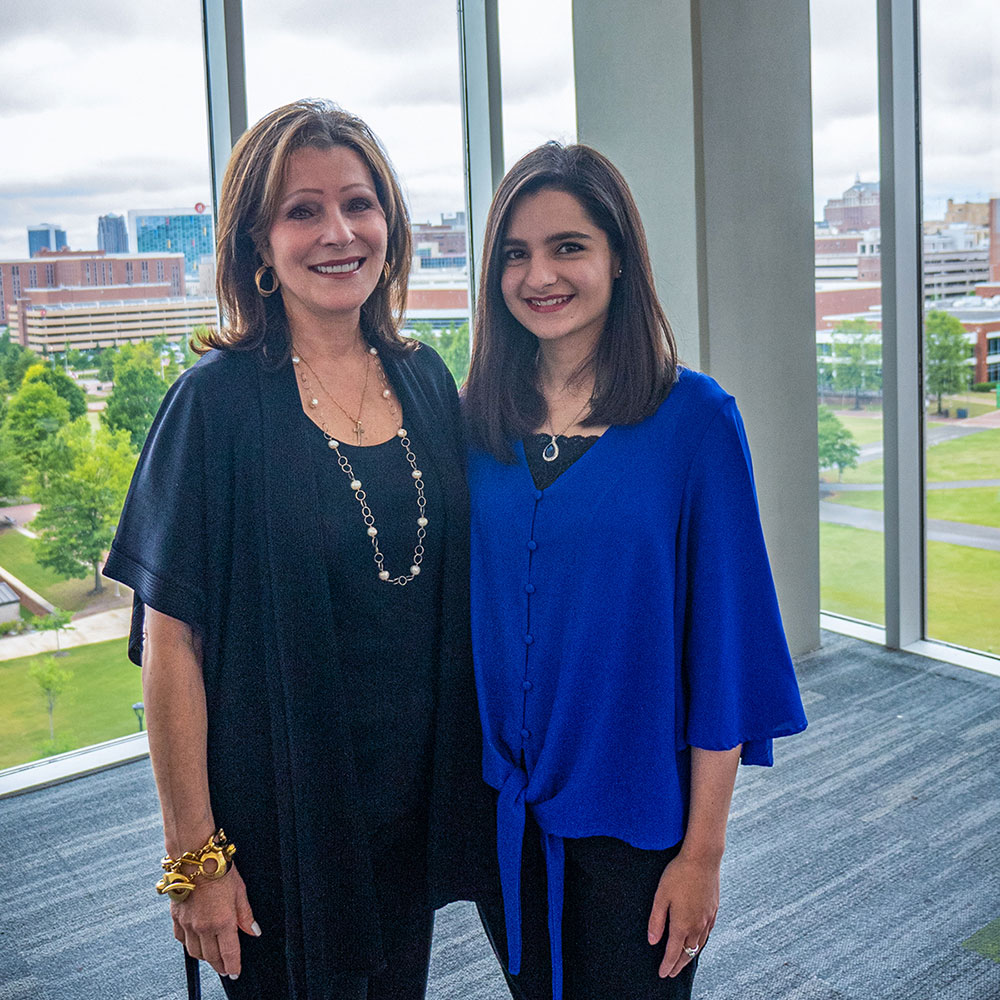 Jacquelyn S. Shaia and Tehreem Khan. Photos by Studio Moderne.This spring, public relations students from UAB took home an astounding number of awards at the annual conference for the Public Relations Council of Alabama (PRCA)—the state’s largest organization for public relations practitioners. Students in the UAB Public Relations Council of Alabama/Public Relations Student Society of America (PRCA/PRSSA) won 46 individual awards and the UAB chapter was awarded the Bettie W. Hudgens Student Chapter of the Year Award. Senior Tehreem Khan was also named Student of the Year, an award that recognizes academic achievement in the field of public relations as well as leadership on campus and in the community.
Jacquelyn S. Shaia and Tehreem Khan. Photos by Studio Moderne.This spring, public relations students from UAB took home an astounding number of awards at the annual conference for the Public Relations Council of Alabama (PRCA)—the state’s largest organization for public relations practitioners. Students in the UAB Public Relations Council of Alabama/Public Relations Student Society of America (PRCA/PRSSA) won 46 individual awards and the UAB chapter was awarded the Bettie W. Hudgens Student Chapter of the Year Award. Senior Tehreem Khan was also named Student of the Year, an award that recognizes academic achievement in the field of public relations as well as leadership on campus and in the community.
The UAB PRCA/PRSSA is a student-led organization open to students across campus who are interested in public relations. The organization conducts workshops, hosts networking events and guest speakers, and offers service-based learning in the community. The student group is a valuable extension of the public relations academic program in the Department of Communication Studies, where students take what they’re learning in the classroom and put it into practice.
In 2016, Jacquelyn S. Shaia, J.D., Ph.D., assistant professor in the Department of Communication Studies and faculty advisor for the chapter, took a small but successful PRCA/PRSSA program and brought it to the national level. The student chapter received its first national recognition in 2020, earning the prestigious PRSSA Star Chapter of the Year award for the first time in the program’s history. Despite its small size—around 60 students and only one full-time faculty member—the UAB PR program has earned the reputation of being one of the finest in the country.
Arts & Sciences magazine sat down with Shaia and Khan to learn more about the program and their collaborative mentoring relationship. This interview has been edited for length and clarity.
A&S Magazine: Let's start with each of you telling me about yourself and how you ended up at UAB.
Tehreem Khan: My name is Tehreem Khan. I am a communication studies major with a concentration in mass communications with a focus in public relations. I moved to Birmingham in 2016 [and attended] two years of high school here, and I knew that I was going to stay with my family. So, I was looking around at my local [higher education] options. My sister was already enrolled at UAB, and she said, “You need to go to UAB because that’s the best place Birmingham has.” So, she gave me a tour, and when I toured this campus, I fell in love with it.
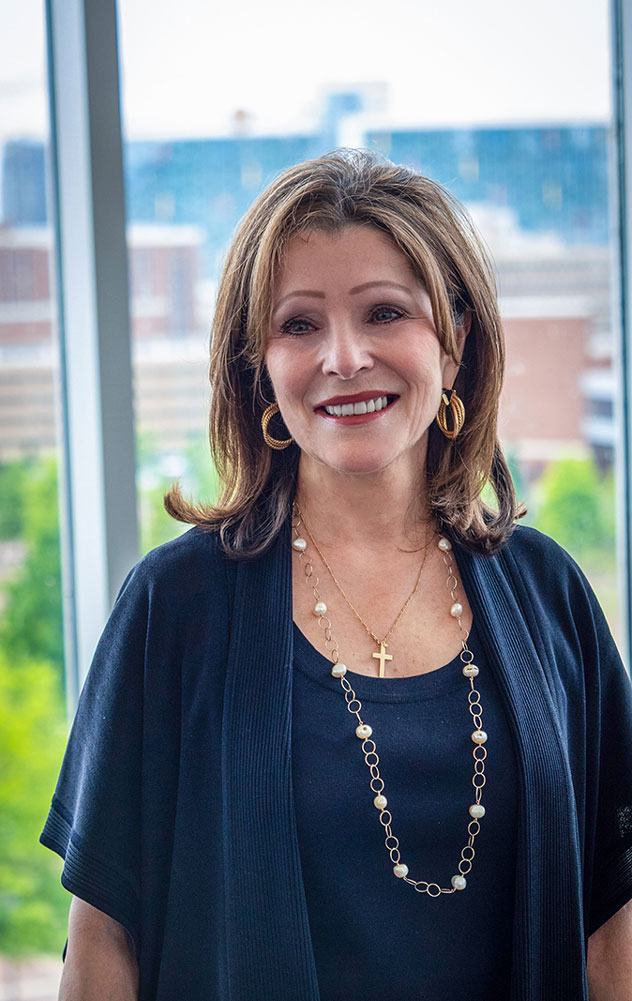
Jacquelyn Shaia: Mine’s a little longer... When I graduated from high school, I went to work the next day for a law firm in Montgomery. I always wanted to go to college, but I had no money to go to college. One of our clients was Dr. James Hicks, and he was the chair of the Division of Otolaryngology in the UAB School of Medicine’s Department of Surgery. I came to know Dr. Hicks when he was coming in and out of the office, and he said, “Well, if you want to go to college you should come to UAB.” So, I started working for Dr. Hicks at UAB while attending school. After I graduated from UAB, I got a scholarship to law school and went on to practice law for years in corporate at BellSouth where public relations was one of my clients. I later worked for the Business Council of Alabama as the head of strategic planning and fundraising. Then I was hired by Alabama Power [to serve as] the President and CEO of the Alabama Power Foundation as well as Senior Vice President of Public Relations, Economic Development, and Corporate Services. I also served as President and CEO of the Economic Development Partnership of Alabama, recruiting industry to this state. It seemed like every job I had involved public relations in some capacity. Public relations is many things: it’s vitally strategic, it's relationship building, it's getting to know people, it's certainly getting to know your audience. It's tailoring your message to the audience so they can understand it. And, most importantly, it has to be ‘mutually beneficial’ for both parties—where both parties feel successful—in order to be effective.
I had always wanted to get a Ph.D. I thought it would be fun—and it really was. [In 2002,] I started the Ph.D. program at the University of Alabama [in Tuscaloosa]. I started teaching media law and taught the entire time I worked on my Ph.D. After I received my doctorate, I really had no intention of working full-time teaching, but then I got a call from UAB. I taught media law and crisis management classes in UAB’s outstanding Honors College and now work with remarkable faculty in the Department of Communication Studies in the College of Arts and Sciences.
A&S: Tehreem, how did you become interested in PR?
TK: As a child, I was involved in school debating competitions in both English and Urdu (Pakistan’s national language). Most of my family belongs to the education sector in Pakistan. My dad is a professor, and he always encouraged academic excellence, leadership, and public speaking. When I would go on the stage as a host or as a debater, his eyes would light up and that meant the world to me. [Also,] I would sit with him and watch news shows. It was very cool that when the [news] anchors were talking, [my family] would pause and listen; their opinion really mattered. And I thought that if they were changing the opinions of people who lived in my household, it meant they were changing the opinions of society at large. That was very inspiring to me, and I knew that I wanted a career in mass communication. The power of the pen and the power of voice really resonated with me ever since I was a child. When I got into UAB, I knew I wanted to do mass communication, [but] I didn't even know what PR was at that time. So, when I was taking an “Ethics and Leadership” [course] with Dr. Shaia, I gave a presentation, and then after the presentation, [Dr. Shaia] pulled me aside and said, “Tehreem, I want you in my program.” As a foreigner, especially, it meant a lot to me that someone in the U.S. is telling me, “Hey, I'll mentor you… I will lead you. I will support you. I will expose you to these opportunities.” So I consulted with my father, and he said, “You should definitely do this.” The next semester, I enrolled in all the PR classes.
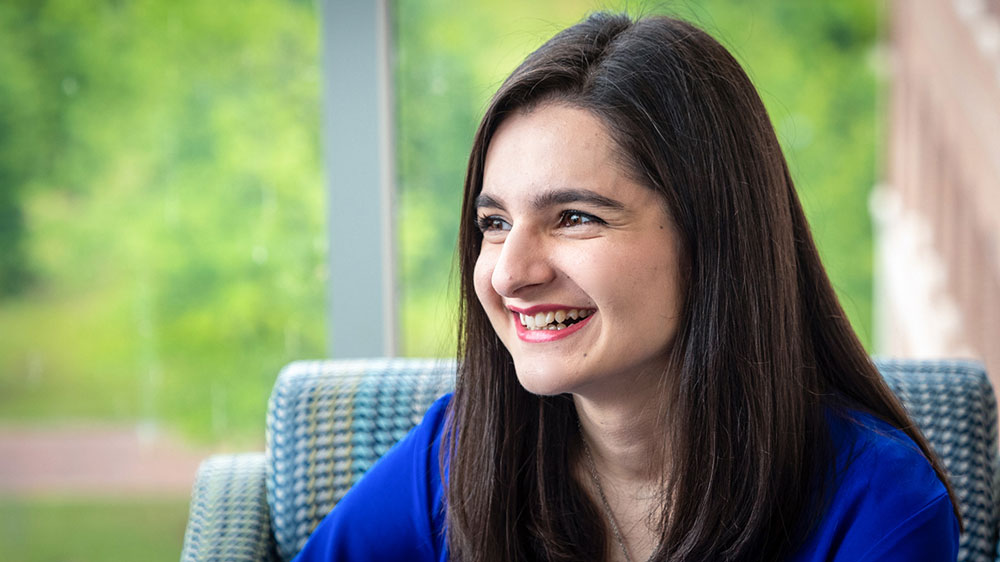
A&S: Dr. Shaia, what was your vision for the PRCA/PRSSA student chapter in relation to the public relations academic program?
JS: The public relations student chapter was successful on its own when I took it on. It received Chapter of the Year from the Public Relations Council of Alabama (PRCA) for many years. But all the emphasis was on that Chapter of the Year [award], not on the individual development, and I wanted both. I also wanted to start extending nationally. We had absolutely no national involvement at all when I came in. So, the first year, off the bat, we had students who served on committees on the national Public Relations Student Society of America. Within a couple of years, we applied for Star Chapter (a national award), and we got it—and that had never been done before at UAB. We've been able to get that award every successive year since then.
When I first came here, leadership and ethics was not a required part of the public relations [curriculum], and I truly believed it needed to be. So, we changed the catalog. We made “Ethics and Leadership” a required course in the public relations [academic program] because you cannot be a true professional without honesty and integrity and a firm understanding of how to apply those values in the workplace. Throughout the program, and particularly with the chapter work, I try to give [students] a heavy dose of what to expect in the professional world and a solid understanding of all the soft skills that they're going to need. I try to bring a perspective of experience on how it really works in the real world. The whole idea is to make our students as competitive as they can be when they graduate with all the skills they need to be successful.
A&S: Tehreem, how has being in the student chapter set you up for success throughout your undergraduate career?
TK: I think it has been critical… I think being part of the student chapter teaches skills that books cannot teach. Books can’t teach you [how to work with] people, and [being part of the chapter] helps you learn how to deal with different personalities. Some people want to be micromanaged, and some people want to work independently. Figuring out how everyone wants to work and [developing] your leadership strategy according to that [is important]. I also think becoming a part of the student organization is important because, as a student, you need reassurance that what you’re doing is worth it and to have [those] opportunities for recognition. [Also], I didn’t have the resources that [allowed me] to pay for my education in the United States on my own. But, as part of the student chapter, I was exposed to a lot of scholarship opportunities, which helped me pay for what I'm doing.
"I literally walked into this program as a student, and I am proud to say that I'm leaving as a professional." — Tehreem Khan
Simply put—[and] this might sound like a cliche statement—but I literally walked into this program as a student, and I am proud to say that I'm leaving as a professional.
A&S: Tell me about the community engagement aspect of the program.
JS: Oh, I love this. I love the community and our state and am extremely grateful to the strong practicing professionals we have in this field in the Southeast. I was adamant that [students] start working with practitioners and expand their networks. Professionals in the Southeast volunteer their time to critique our students’ work. More importantly, students get another set of eyes on their work. We also select small groups of students and then pair them with nonprofits based on each group's interest to create and deliver real public relations campaigns. There’s no shortage, as I tell the students, of noble causes in the state. There are opportunities everywhere, and we just have to look for them. These small nonprofits don't have any public relations support and are just so grateful for our help. The last class in the program is our capstone class, and we conclude with a competition. I bring in four PR practitioners from across the state who serve as judges and hear presentations on the campaigns from each of the student groups. After deliberation, they decide which campaign was the best and offer very valuable feedback on ways each of the campaigns can be improved. This is tremendously helpful to the students, and they graduate having strategically developed—and delivered—a very extensive campaign for a struggling nonprofit which badly needs help.
TK: I think working with nonprofit organizations gives purpose. The other thing is the nonprofit organizations that we work with at UAB are pretty small. In a bigger organization, you [might] have a photographer, videographer, social media person, media relations person. But when working with a small nonprofit organization—and we are working for them pro bono—we are the photographer, we are the videographer, we are the social media person, and we are their media relations person. We are their PR person… so it not only helps them but builds our professional skills. It is an opportunity to do things out of our comfort zone.
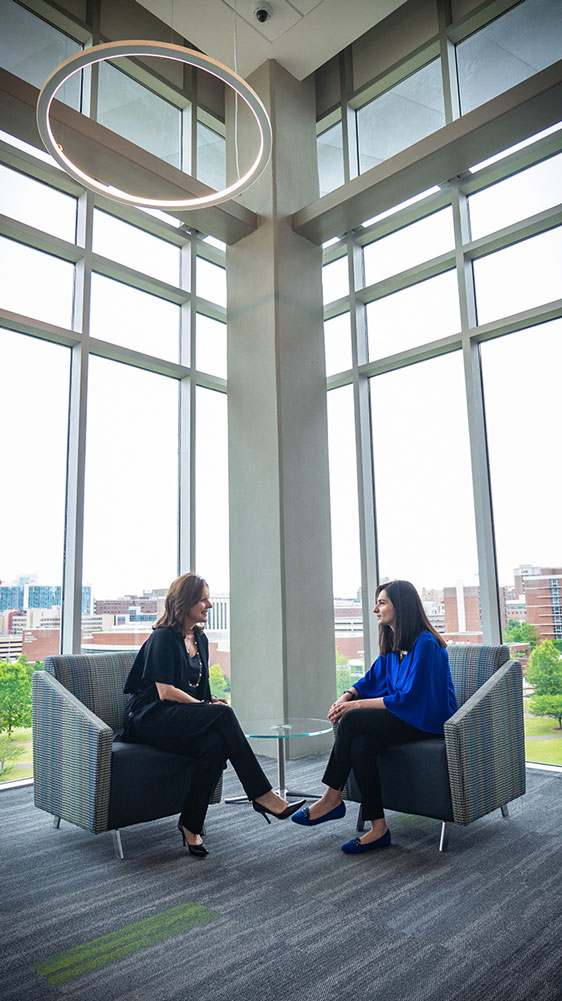
A&S: How does the mentor/mentee relationship between students and faculty lend itself to the program’s success?
TK: [To some], it may be considered a weakness that it's a small program but, to me, it's a strength. We have a small group of [students] and one faculty member, which helps us build connections amongst ourselves and with Dr. Shaia.
I’ve had a lot of people tell me, “You’re doing a great job!” You [also] need a person who is really honest with you, and with a mentor like [Dr. Shaia], you're going to know… So having those people who are not just appreciative of your good work, but also can tell you, “Here's what you're doing wrong,” so that you don't make those mistakes in a high-stakes situation… This is what mentorship is.
JS: The thing I keep in mind on mentoring is students need to always trust you and know that when you give them positive [feedback], it's positive. And when you give them things that need to be improved upon, they can trust you. Suggestions for improvement must be delivered in a way in which the student understands it is for their own benefit.
I'm a big believer in giving big jobs to people who maybe have never done them before. I expect them to succeed, and they do. They [succeed] because they realize that if they just pull from within, they can do this… And I'm going to be there to help them if they need help. They're able to build their confidence up.
There's nothing more gratifying than to see a young person come in with talent, even though the talent is not fully developed. I have always believed you hire for attitude and train for skills, and I still believe that. Hire for attitude, train for skills every time. A mentor or leader cannot micromanage an individual and expect them to succeed and learn. People perform best when they have a strong understanding of the organizational framework—and can use their own talent and creativity to solve the problem. And so, I work with each student to be sure that we go where that student is—not where we think that student ought to be in relation to everybody else… And [I also ask myself] what do I need to do or change in order to develop that student to get them to where they need to be?
TK: Dr. Shaia always says that everyone handles success well, but how you handle failure speaks to who you are as a person. And her statement helps me reflect and humbles me. She shares a lot of life advice in her classes, which I love about her—that’s part of her mentorship to every student.
Learn more about the public relations program at UAB.


